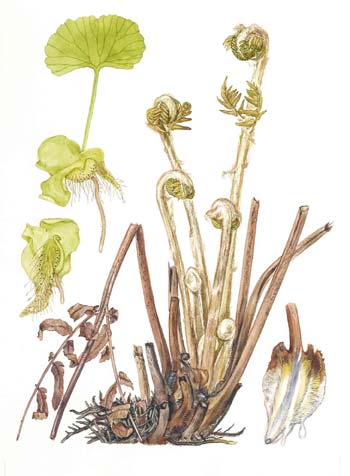|
Hardy Fern Home O. regalis resources All Ferns � Osmundaceae �� Osmunda
�Other Genera
|
| Osmunda regalis | ||
Royal fern, flowering fern | ||
|
Etymology
Regalis means regal, or of outstanding merit.
Description
Rhizome: erect, massive, forming a trunk, occasionally branching, hairs and old stipe bases woven together with black, fibrous roots.
Frond: 120 cm high by 25 cm wide, though sometimes much taller, deciduous, dimorphic, blade/stipe ratio: 1:1. Stipe: stipules (flared leaf base), unique to the family/genus, hairy when young, soon glabrous, vascular bundles: 1 in a U-shape where the top of the arms continue to curl. Blade: 2-pinnate, rachis grooved, somewhat waxy, shedding water, reddish to light brown hairs, soon falling. Pinnae: 5 to 9 pair, catadromous, often jointed at the rachis, rotated to the horizontal; on fertile fronds usually the two to four lowest pair are sterile; pinnules oblong, to 8 cm, 8-12 pairs plus a terminal pinnule; margins almost entire, the tip of the pinnules serrate; veins free, forked. Sori: none, indusium: absent, sporangia: large, globose, tan or black when mature, spores green, maturity: early to midsummer. Dimensionality: horizontal pinnae. Culture
Habitat: wet, acidic swamps, bogs.
Distribution: Europe and northern Africa, eastern North America.
Hardy to -40�C, USDA Zone 2.
Distinctive Characteristics
Distinguished from other Osmunda by having fertile pinnae above sterile pinnae and 2-pinnate; distinguish from all other ferns by the generic characters: no sorus, no indusium, naked sporangium, winged stipe bases.
|
|
|
Notes
var spectabilis The North American version has thinner, more distant segments, and fewer hairs. The European variety, regalis, is stouter and very much larger, up to 2�meters or more�in bogs.
var spectabilis The North American version has thinner, more distant segments, and fewer hairs. The European variety, regalis, is stouter and very much larger, up to 2�meters or more�in bogs.

Osmunda regalis. Left to right: gametophyte, first flabellate frond; emergence; base of petiole with flanges and dripping mucillage. �Illustration from Scandinavian Ferns by Benjamin �llgaard and Kirsten Tind, Rhodos, 1993. |
